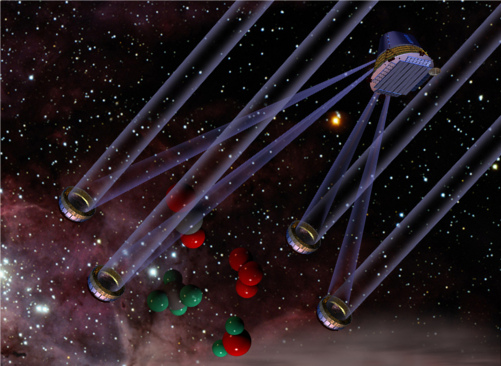The DARWIN mission
The DARWIN mission, if eventually selected by the European Space Agency (ESA) should allow, around 2025, to study the new extrasolar planets and to discover potential traces of primitive life. The development of the instrumental concept exhibits several keypoints both in scientific and also in technological respect.
Scientific context of the mission
Currently employed methods in the search for exoplanets, which to date have allowed to discover over 400 objects (Nov. 2009, up-to-date list available at the Extrasolar Planets Encyclopaedia), are so-called indirect methods: The planets are detected by observing and very precisely measuring the movements which they impose on their central star (astrometry, radial velocity) or by the effects they have on the brightness of the star (transit, microlensing). These different methods do not allow to "see" the detected planets directly and even less so to perform a spectral analysis on them which can give us information about the surface composition of these objects.
The DARWIN concept is one of an instrument that is capable of separating the light of a planet and that of its central star in order to allow exactly that spectral analysis. It is one of the few instruments foreseeable in the coming years that would be capable to detect molecules in the planetary atmosphere such as carbon dioxide (CO2), characteristic for telluric planets (little rocky planets in the Solar System like Mercury, Venus, Earth, Mars, the Moon ...), water (H2O), ozone (O3) and therefore oxygen (O2). The simultaneous presence of oxygen in large amounts, of water, and of carbon dioxide appears to be a good indicator of photosynthesis. All of these chemical species are detectable in the infra-red (the domain of electromagnetic frequencies where the ratio of the luminous flux from the star and from the planet is optimal) in a band that extends from 6 to 18 microns wavelength. Since this "spectral window" is not fully accessible by earth-bound observations, it is necessary to consider a space mission in order to achieve this objective. The DARWIN mission could gather in the near future the first indications that would allow to answer the fundamental question: Does Life exist exclusively on Earth? And in more general terms, what is the probability for Life to appear in the universe?
More about DARWIN: DARWIN website at ESA




